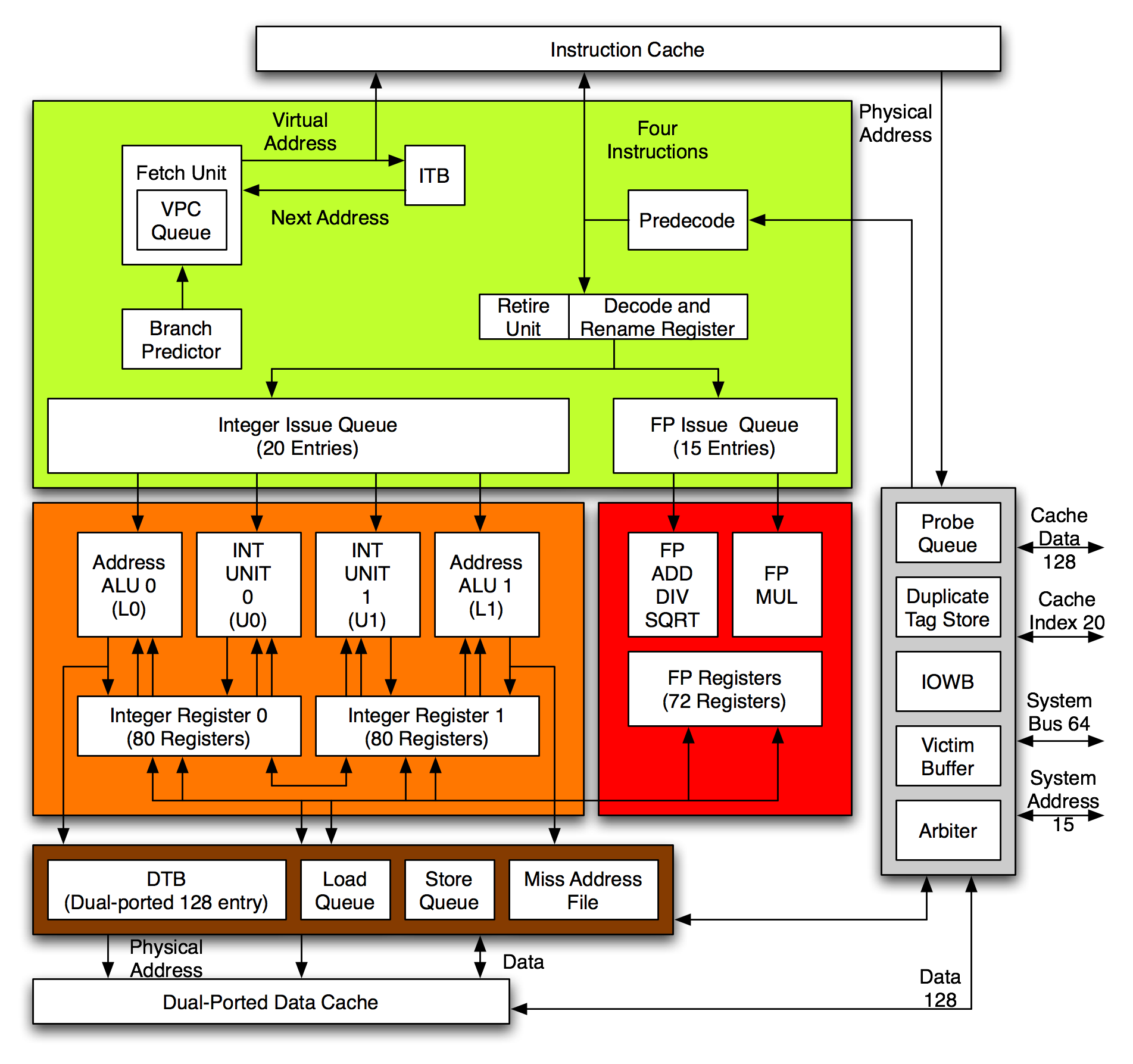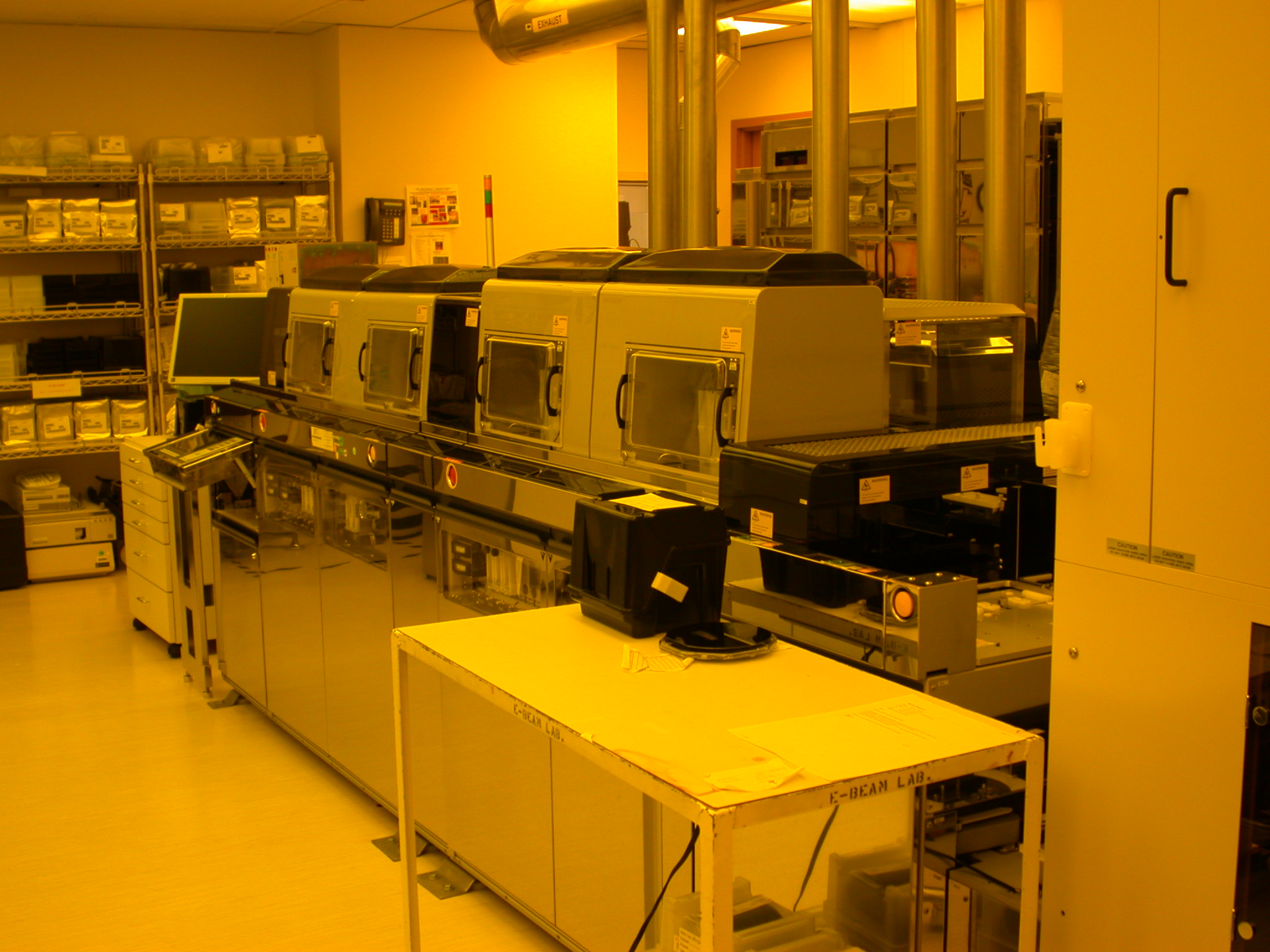|
Alpha 21264
The Alpha 21264, also known by its code name, EV6, is a RISC microprocessor developed by Digital Equipment Corporation launched on 19 October 1998. The 21264 implemented the Alpha instruction set architecture (ISA). Description The Alpha 21264 is a four-issue superscalar microprocessor with out-of-order execution and speculative execution. It has a peak execution rate of six instructions per cycle and could sustain four instructions per cycle. It has a seven-stage instruction pipeline. Out of order execution At any given stage, the microprocessor could have up to 80 instructions in various stages of execution, surpassing any other contemporary microprocessor. Decoded instructions are held in instruction queues and are issued when their operands are available. The integer queue contained 20 entries and the floating-point queue 15. Each queue could issue as many instructions as there were pipelines. Ebox The Ebox executes integer, load and store instructions. It has two inte ... [...More Info...] [...Related Items...] OR: [Wikipedia] [Google] [Baidu] |
Alpha 21264
The Alpha 21264, also known by its code name, EV6, is a RISC microprocessor developed by Digital Equipment Corporation launched on 19 October 1998. The 21264 implemented the Alpha instruction set architecture (ISA). Description The Alpha 21264 is a four-issue superscalar microprocessor with out-of-order execution and speculative execution. It has a peak execution rate of six instructions per cycle and could sustain four instructions per cycle. It has a seven-stage instruction pipeline. Out of order execution At any given stage, the microprocessor could have up to 80 instructions in various stages of execution, surpassing any other contemporary microprocessor. Decoded instructions are held in instruction queues and are issued when their operands are available. The integer queue contained 20 entries and the floating-point queue 15. Each queue could issue as many instructions as there were pipelines. Ebox The Ebox executes integer, load and store instructions. It has tw ... [...More Info...] [...Related Items...] OR: [Wikipedia] [Google] [Baidu] |
Alpha 21164
The Alpha 21164, also known by its code name, EV5, is a microprocessor developed and fabricated by Digital Equipment Corporation that implemented the Alpha instruction set architecture (ISA). It was introduced in January 1995, succeeding the Alpha 21064A as Digital's flagship microprocessor. It was succeeded by the Alpha 21264 in 1998. History First silicon of the Alpha 21164 was produced in February 1994, and the OpenVMS, Digital UNIX and Windows NT operating systems were successfully booted on it. It was sampled in late 1994 and was introduced in January 1995 at 266 MHz. A 300 MHz version was introduced in March 1995. The final Alpha 21164, a 333 MHz version, was announced on 2 October 1995, available in sample quantities. The Alpha 21164 was replaced by the Alpha 21164A as Digital's flagship microprocessor in 1996 when a 400 MHz version became available in volume quantities. Users Digital used the Alpha 21164 operating at various clock frequencies in the ... [...More Info...] [...Related Items...] OR: [Wikipedia] [Google] [Baidu] |
Semiconductor Device Fabrication
Semiconductor device fabrication is the process used to manufacture semiconductor devices, typically integrated circuits (ICs) such as microprocessors, microcontrollers, and memories (such as Random-access memory, RAM and flash memory). It is a multiple-step Photolithography, photolithographic and physico-chemical process (with steps such as thermal oxidation, thin-film deposition, ion-implantation, etching) during which electronic circuits are gradually created on a wafer (electronics), wafer, typically made of pure single-crystal semiconducting material. Silicon is almost always used, but various compound semiconductors are used for specialized applications. This article focuses on the manufacture of integrated circuits, however steps such as etching and photolithography can be used to manufacture other devices such as LCD and OLED displays. The fabrication process is performed in highly specialized semiconductor fabrication plants, also called foundries or "fabs", with the cen ... [...More Info...] [...Related Items...] OR: [Wikipedia] [Google] [Baidu] |
CMOS
Complementary metal–oxide–semiconductor (CMOS, pronounced "sea-moss ", , ) is a type of MOSFET, metal–oxide–semiconductor field-effect transistor (MOSFET) semiconductor device fabrication, fabrication process that uses complementary and symmetrical pairs of p-type semiconductor, p-type and n-type semiconductor, n-type MOSFETs for logic functions. CMOS technology is used for constructing integrated circuit (IC) chips, including microprocessors, microcontrollers, memory chips (including Nonvolatile BIOS memory, CMOS BIOS), and other digital logic circuits. CMOS technology is also used for analog circuits such as image sensors (CMOS sensors), data conversion, data converters, RF circuits (RF CMOS), and highly integrated transceivers for many types of communication. In 1948, Bardeen and Brattain patented an insulated-gate transistor (IGFET) with an inversion layer. Bardeen's concept forms the basis of CMOS technology today. The CMOS process was presented by Fairchild Semico ... [...More Info...] [...Related Items...] OR: [Wikipedia] [Google] [Baidu] |
Alpha 21064
The Alpha 21064 is a microprocessor developed and fabricated by Digital Equipment Corporation that implemented the Alpha (introduced as the Alpha AXP) instruction set architecture (ISA). It was introduced as the DECchip 21064 before it was renamed in 1994. The 21064 is also known by its code name, EV4. It was announced in February 1992 with volume availability in September 1992. The 21064 was the first commercial implementation of the Alpha ISA, and the first microprocessor from Digital to be available commercially. It was succeeded by a derivative, the Alpha 21064A in October 1993. This last version was replaced by the Alpha 21164 in 1995. History The first Alpha processor was a test chip codenamed EV3. This test chip was fabricated using Digital's 1.0-micrometre (μm) CMOS-3 process. The test chip lacked a floating point unit and only had 1 KB caches. The test chip was used to confirm the operation of the aggressive circuit design techniques. The test chip, along with ... [...More Info...] [...Related Items...] OR: [Wikipedia] [Google] [Baidu] |
Athlon
AMD Athlon is the brand name applied to a series of x86, x86-compatible microprocessors designed and manufactured by AMD, Advanced Micro Devices. The original Athlon (now called Athlon Classic) was the first seventh-generation x86 processor and the first desktop processor to reach speeds of one gigahertz (GHz). It made its debut as AMD's high-end processor brand on June 23, 1999. Over the years AMD has used the Athlon name with the 64-bit Athlon 64 architecture, the Athlon II, and Accelerated Processing Unit (APU) chips targeting the Socket AM1 desktop System on a chip, SoC architecture, and Socket AM4 Zen (microarchitecture). The modern Zen-based Athlon with a Radeon, Radeon Graphics processor was introduced in 2019 as AMD's highest-performance entry-level processor. Brand history K7 design and development The first Athlon processor was a result of AMD's development of K7 processors in the 1990s. AMD founder and then-CEO Jerry Sanders (businessman), Jerry Sa ... [...More Info...] [...Related Items...] OR: [Wikipedia] [Google] [Baidu] |
Advanced Micro Devices
Advanced Micro Devices, Inc. (AMD) is an American multinational corporation and technology company headquartered in Santa Clara, California and maintains significant operations in Austin, Texas. AMD is a Information technology, hardware and Fabless manufacturing, fabless company that designs and develops List of AMD processors, central processing units (CPUs), List of AMD graphics processing units, graphics processing units (GPUs), field-programmable gate arrays (FPGAs), System on a chip, system-on-chip (SoC), and high-performance computing, high-performance computer solutions. AMD serves a wide range of business and consumer markets, including gaming, data centers, artificial intelligence (AI), and embedded systems. AMD's main products include List of AMD microprocessors, microprocessors, motherboard chipsets, embedded processors, and List of AMD graphics processing units, graphics processors for Server (computing), servers, workstations, personal computers, and embedded syst ... [...More Info...] [...Related Items...] OR: [Wikipedia] [Google] [Baidu] |
Control Bus
In computer architecture, a control bus is part of the system bus and is used by central processing unit, CPUs for communicating with other devices within the computer. While the address bus carries the information about the device with which the CPU is communicating and the Bus (computing), data bus carries the actual data being processed, the control bus carries commands from the CPU and returns status signals from the devices. For example, if the data is being read or written to the device the appropriate line (read or write) will be active (logic one). Lines The number and type of lines in a control bus varies but there are basic lines common to all microprocessors, such as: * Read (\overline ). A single line that when active (logic zero) indicates the device is being read by the CPU. * Write (\overline ). A single line that when active (logic zero) indicates the device is being written by the CPU. * Byte enable (\overline E). A group of lines that indicate the size of the d ... [...More Info...] [...Related Items...] OR: [Wikipedia] [Google] [Baidu] |
Address Bus
In computer architecture, a bus (historically also called a data highway or databus) is a communication system that transfers data between components inside a computer or between computers. It encompasses both hardware (e.g., wires, optical fiber) and software, including communication protocols. At its core, a bus is a shared physical pathway, typically composed of wires, traces on a circuit board, or busbars, that allows multiple devices to communicate. To prevent conflicts and ensure orderly data exchange, buses rely on a communication protocol to manage which device can transmit data at a given time. Buses are categorized based on their role, such as system buses (also known as internal buses, internal data buses, or memory buses) connecting the CPU and memory. Expansion buses, also called peripheral buses, extend the system to connect additional devices, including peripherals. Examples of widely used buses include PCI Express (PCIe) for high-speed internal connectio ... [...More Info...] [...Related Items...] OR: [Wikipedia] [Google] [Baidu] |
Bus (computing)
In computer architecture, a bus (historically also called a data highway or databus) is a communication system that transfers Data (computing), data between components inside a computer or between computers. It encompasses both Computer hardware, hardware (e.g., wires, optical fiber) and software, including communication protocols. At its core, a bus is a shared physical pathway, typically composed of wires, traces on a circuit board, or busbars, that allows multiple devices to communicate. To prevent conflicts and ensure orderly data exchange, buses rely on a communication protocol to manage which device can transmit data at a given time. Buses are categorized based on their role, such as system buses (also known as internal buses, internal data buses, or memory buses) connecting the Central processing unit, CPU and Computer memory, memory. Expansion buses, also called peripheral buses, extend the system to connect additional devices, including peripherals. Examples of widely ... [...More Info...] [...Related Items...] OR: [Wikipedia] [Google] [Baidu] |
Branch Predictor
In computer architecture, a branch predictor is a digital circuit that tries to guess which way a branch (e.g., an if–then–else structure) will go before this is known definitively. The purpose of the branch predictor is to improve the flow in the instruction pipeline. Branch predictors play a critical role in achieving high performance in many modern pipelined microprocessor architectures. Two-way branching is usually implemented with a conditional jump instruction. A conditional jump can either be "taken" and jump to a different place in program memory, or it can be "not taken" and continue execution immediately after the conditional jump. It is not known for certain whether a conditional jump will be taken or not taken until the condition has been calculated and the conditional jump has passed the execution stage in the instruction pipeline (see fig. 1). Without branch prediction, the processor would have to wait until the conditional jump instruction has passed the ... [...More Info...] [...Related Items...] OR: [Wikipedia] [Google] [Baidu] |

